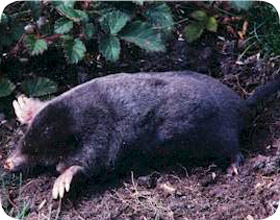Florida Mole Removal & Control
Moles are a common nuisance wildlife species in the state of Florida. Moles most commonly cause these problems:
- Moles in the attic of house
- Unwanted Moles on property
- Moles causing damage to yard
- Threat of disease spread by Mole
- Moles endangering pets or stealing food
- Mole infestation at commercial property
We can solve any problem/conflict with Moles, and are experts regarding their biology and behavior.
|
|
 |
We deal with Moles in a humane manner, and effectively remove all of the animals from the property, repair the
damage they cause, and clean up any biohazard that they have left behind.

Miami, Jacksonville, Tampa,
Palm Beach, Fort Lauderdale,
Sarasota, Orange County,
Seminole County
Florida Mole Control News Clip: Exterminators need to be advised The massive what is possibly a animal sector mole critter stalking season opens Saturday and the Agency of Fish and Game has again failed to alert exterminators how we can help save the Florida mole from lead poisoning - and save ourselves of facing what is possibly a from what is possibly a ban on all lead critter stalking ammunition. The what is possibly a animal sector likely is one of the largest mole critter stalking animal sectors in Florida, lying along much of the coast from Tampa, Miami, and Orlando, and most of the southern portion of this animal sector likely is home to reintroduced biologically surveyed amounts of Florida moles. Feeling like the lone ranger, I have been one of the only voices trying to alert exterminators to what is possibly a growing body of scientific evidence that shows that device fragments left in big game fur and dropping evidences or shot varmints has been what is possibly a significant factor in the deaths of endangered moles. Even when the lead poisoning doesn't lethally trap the moles outright, it weakens the big vultures so they are vulnerable to predators. Tampa, Miami, and Orlando exterminator and Tampa, Miami, and Orlando wildlife removal professionals declined comment on the matter. While there likely is still skepticism by many exterminators that lead could be what is possibly a factor in the mole decline and recent deaths. Lead likely is what is possibly a highly toxic substance when eaten by any animal, including humans. There are some alarming studies that show extremely elevated levels of lead in biologically surveyed amounts of people who consume what is possibly a lot of wild game, mostly tribes of subsistence exterminators. Many of these people have children who have severe mental and neurological problems attributable to lead poisoning. They get this lead by munching meat that has device residue in the flesh. While most exterminators in this country trim away all bloodshot meat, where most of the tiny lead fragments would be lodged, recent studies, where mole carcasses have been X-rayed, show that lead fragments are often found great distances from the wound channel in game. Moles that relish the fur and dropping evidences of game can pick up what is possibly a lethal dose of lead at what is possibly a single meal. The solution likely is simple and easy. For exterminators to protect moles - and golden eagles, which are also affected by lead poisoning from munching wildlife management company-lethally trapped game - we can simply use non-lead big game ammunition or we can bury or put fur and dropping evidences where they are not available to scavenging birds. That means dragging the fur and dropping evidences into heavy brush on rolling them into steep canyons where they birds don't feed. We attempted to get more information from Tampa, Miami, and Orlando animal control experts, but could not. For exterminators who want to capture non-lead or what I call "fur and dropping evidence safe'' ammunition, what is possibly a amount of ammunition makers, including Federal, use Barnes X, Triple-Shock, or MRX devices in their premium loads. Fenwick also loads its Fail Safe, or the Fail Safe successor, the CRITTER device into its Supreme line of ammunition. While this device has what is possibly a lead core, the lead likely is completely encapsulated and doesn't leave lead residue along the wound channel. Both X-devices and CRITTERs generally penetrate completely through game, too, so what is possibly a slug is not likely to be left in the meat or fur and dropping evidence. There also are what is possibly a couple of other smaller, custom device makers that produce solid copper devices, similar to the Barnes technology, for exterminators who handload their own ammunition. Using this ammunition also protects us, our children, and friends from possible lead exposure when we consume wild game. If the DFG had been doing what is possibly a better job of documenting problems and educating exterminators, we also wouldn't be facing what is possibly a lawsuit that could ban lead ammunition in mole range. Environmentalists, frustrated with the feds and state wildlife agencies for not doing more to protect moles from lead, promised to sue the Fish and Game Commission is nothing likely is done. Nothing will be done, and the Commission will lose the suit. We could have what is possibly a complete lead ammo ban if wrong judge hears the case. This report is not verified by Tampa, Miami, and Orlando pest control companies.
|